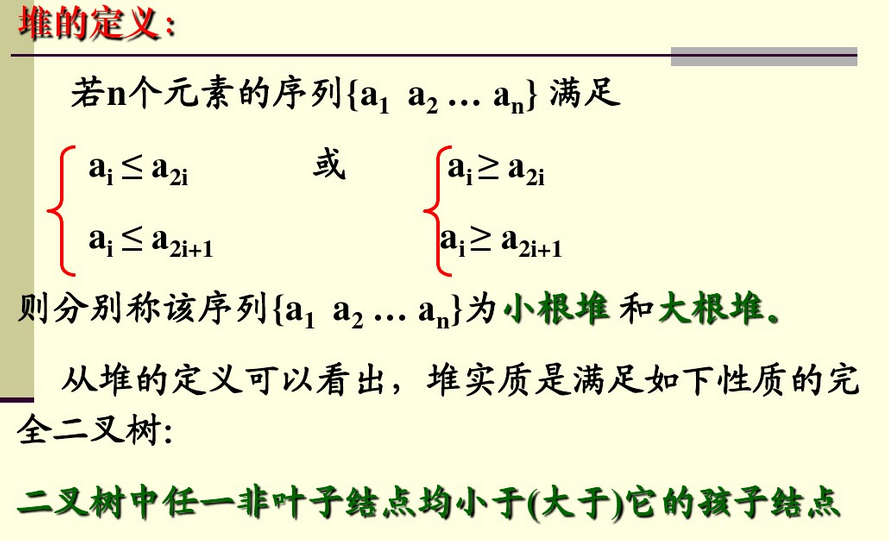1、冒泡排序
算法描述:
-
比较相邻的元素。如果第一个比第二个大,就交换他们两个。
-
对每一对相邻元素作同样的工作,从开始第一对到结尾的最后一对。在这一点,最后的元素应该会是最大的数。
-
针对所有的元素重复以上的步骤,除了最后一个。
-
持续每次对越来越少的元素重复上面的步骤,直到没有任何一对数字需要比较
时间复杂度:O(n^2)
public class BubbleSort {
static int count = 0;
static int[] shulie = new int[] {87,2,548,22,453,21,9,432,75,21,33,88};
public static void main(String[] args) {
for (int i = shulie.length; 0 < i; i--) {
for (int j = 0; j < i-1; j++) {
if (shulie[j] > shulie[j+1]) {
swap(j, j+1);
}
count++;
}
}
System.out.println(Arrays.toString(shulie));
System.out.println("比较次数:" + count);
}
static void swap(int a, int b) {
shulie[a] = shulie[a] + shulie[b];
shulie[b] = shulie[a] - shulie[b];
shulie[a] = shulie[a] - shulie[b];
}
}
2、快速排序
算法描述:
- 设置两个变量i、j,排序开始的时候:i=0,j=N-1;
- 以第一个数组元素作为关键数据,赋值给key,即key=A[0];
- 从j开始向前搜索,即由后开始向前搜索(j--),找到第一个小于key的值A[j],将A[j]和A[i]互换;
- 从i开始向后搜索,即由前开始向后搜索(i++),找到第一个大于key的A[i],将A[i]和A[j]互换;
- 重复第3、4步,直到i=j; (3,4步中,没找到符合条件的值,即3中A[j]不小于key,4中A[i]不大于key的时候改变j、i的值,使得j=j-1,i=i+1,直至找到为止。找到符合条件的值,进行交换的时候i, j指针位置不变。另外,i==j这一过程一定正好是i+或j-完成的时候,此时令循环结束)
时间复杂度:O(n^2)
public class QuickSort {
static int count = 0;
static int[] shulie = new int[] {87,2,548,22,453,21,9,432,75,21,33,88};
static void swap(int a, int b) {
shulie[a] = shulie[a] + shulie[b];
shulie[b] = shulie[a] - shulie[b];
shulie[a] = shulie[a] - shulie[b];
}
public static void main(String[] args) {
kp(0, shulie.length-1);
System.out.println(Arrays.toString(shulie));
System.out.println("比较次数:" + count);
}
static void kp(int from, int to) {
boolean direct = true;
int i=from, j=to, k=shulie[from];
while (i!=j) {
if (direct) {
if (shulie[j] < k) {
swap(i, j);
direct=false;
} else {
j--;
}
} else {
if (shulie[i] > k) {
swap(i, j);
direct = true;
} else {
i++;
}
}
count++;
}
if (to-from > 1) {
if (i-1 >= from) {
kp(from,i-1);
}
if (i+1 <= to) {
kp(i+1,to);
}
}
}
}
3、堆排序
概念:
1、堆:

2、算法描述:
- 先将初始文件R[1..n]建成一个大根堆,此堆为初始的无序区
- 再将关键字最大的记录R[1](即堆顶)和无序区的最后一个记录R[n]交换,由此得到新的无序区R[1..n-1]和有序区R[n],且满足R[1..n-1].keys≤R[n].key
-
由于交换后新的根R[1]可能违反堆性质,故应将当前无序区R[1..n-1]调整为堆。然后再次将R[1..n-1]中关键字最大的记录R[1]和该区间的最后一个记录R[n-1]交换,由此得到新的无序区R[1..n-2]和有序区R[n-1..n],且仍满足关系R[1..n-2].keys≤R[n-1..n].keys,同样要将R[1..n-2]调整为堆。……直到无序区只有一个元素为止。
3、时间复杂度:O(nlgn)
public class HeapSort {
private static int[] sort = new int[] {87,2,548,22,453,21,9,432,75,21,33,88};
private static int count = 0;
public static void main(String[] args) {
buildMaxHeapify(sort);
heapSort(sort);
System.out.println(Arrays.toString(sort));
System.out.println("比较次数:" + count);
}
private static void buildMaxHeapify(int[] data) {
// 没有子节点的才需要创建最大堆,从最后一个的父节点开始
int startIndex = getParentIndex(data.length - 1);
// 从尾端开始创建最大堆,每次都是正确的堆
for (int i = startIndex; i >= 0; i--) {
maxHeapify(data, data.length, i);
}
}
/**
* 创建最大堆
*
* @param data
* @param heapSize 需要创建最大堆的大小,一般在sort的时候用到,因为最多值放在末尾,末尾就不再归入最大堆了
* @param index 当前需要创建最大堆的位置
*/
private static void maxHeapify(int[] data, int heapSize, int index) {
count++;
// 当前点与左右子节点比较
int left = getChildLeftIndex(index);
int right = getChildRightIndex(index);
int largest = index;
if (left < heapSize && data[index] < data[left]) {
largest = left;
}
if (right < heapSize && data[largest] < data[right]) {
largest = right;
}
// 得到最大值后可能需要交换,如果交换了,其子节点可能就不是最大堆了,需要重新调整
if (largest != index) {
int temp = data[index];
data[index] = data[largest];
data[largest] = temp;
maxHeapify(data, heapSize, largest);
}
}
/**
* 排序,最大值放在末尾,data虽然是最大堆,在排序后就成了递增的
*
* @paramdata
*/
private static void heapSort(int[] data) {
// 末尾与头交换,交换后调整最大堆
for (int i = data.length - 1; i > 0; i--) {
int temp = data[0];
data[0] = data[i];
data[i] = temp;
maxHeapify(data, i, 0);
}
}
/**
* 父节点位置
*
* @paramcurrent
* @return
*/
private static int getParentIndex(int current) {
return (current - 1) >> 1;
}
/**
* 左子节点position注意括号,加法优先级更高
*
* @paramcurrent
* @return
*/
private static int getChildLeftIndex(int current) {
return (current << 1) + 1;
}
/**
* 右子节点position
*
* @paramcurrent
* @return
*/
private static int getChildRightIndex(int current) {
return (current << 1) + 2;
}
/**
* 以2为底的对数
*
* @paramparam
* @return
*/
private static double getLog(double param) {
return Math.log(param) / Math.log(2);
}
}